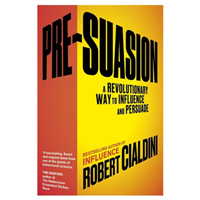 After a 30-year wait, the author of the legendary bestseller Influence: The Psychology of Persuasion
After a 30-year wait, the author of the legendary bestseller Influence: The Psychology of Persuasion, social psychologist Robert Cialdini has written a sequel, Pre-Suasion: A Revolutionary Way to Influence and Persuade
.
Cialdini is recognized worldwide for his inspired field research on the psychology of influence. He is a New York Times bestselling author. His books, including Influence: The Psychology of Persuasion, have sold more than three million copies in thirty-three languages.
As you might expect after the long wait, Pre-Suasion is packed with new research, tactics and insights. Here are a few of the ones that we found most surprising:
- Cialdini argues that reveals that the secret of persuasion doesn’t lie in the message itself, but in the key moment before the message is delivered. Some key moves made before any request can influence your chances of success. Optimal persuasion is achieved only through optimal pre-suasion. As opposed to Influence, which covers what best to build into a message to get an agreement, Pre-suasion describes the process of gaining agreement with a message before it’s been sent. That key moment allows a communicator to create a state of mind in recipients that is consistent with the forthcoming message. For example, when interviewing for a new job, after saying that you want to answer all questions as fully as possible, say one more thing: “But, before we start, I wonder if you could answer a question for me. Why did you invite me to interview today?” As a consequence, your evaluators will hear themselves saying positive things about you and your qualifications, putting themselves in a state of mind that is favourable to your candidacy before you make your case for it!
- The more someone can be involved in the development of a proposal, the more likely they will ‘buy’ into it, and commit to making it happen. Ask your boss for advice concerning your planned work, not for opinions about it. Evaluators who are asked to provide advice (instead of opinions or expectations) on a plan are put in a cooperative state of mind before they even experience the plan, which makes them more favourable to it when they then do encounter it. As the saying goes: “When we ask for advice, we are usually looking for an accomplice.”
- Unsurprisingly, in persuasion, a lot is about similarity, and we are really vulnerable to similarities that are irrelevant, like similar names, ethnic backgrounds, birthdays, and such. Cialdini refers to this as a “unity principle“,” which refers to the perception of shared identity. Unity can be based on other groups: ethnicity, geography, shared interests and many more. The more the individual identifies as being a member of that group, the more powerful the unity effect will be, letting us see others as within “the circle of us”, which is not irredeemably closed, with the right techniques. More than getting targets to like you, selling requires targets to believe you like them, and similarities and compliments produce these beliefs—targets believe that if you like them, you will steer them well. Also social proof, where we follow others and also improve our behaviour if shown that others around us are behaving well, follows this pattern: it is not just about our belief in the wisdom of crowds; it shows that improvement is feasible for people like us.
- Surveys can increase demand: simply asking a question in the right way can put customers in the right frame of mind to buy your product.
The group asked using the word “unhappy” were triggered to dwell on their dissatisfactions, and were almost five times as likely to report being unhappy.
This has major implications for business surveys. What you ask is what you get. Unhappy focused questioners then seek out experiences in their life that fit with the question. - At an important meeting, you might be inclined to sit next to the key influencer; Cialdini says that would be a mistake because of the “next in line” effect: the VIP you want to sway will be least likely to hear your message if you go just before or after her because she’d be rehearsing what she plans to say or what she just said. Instead, sit across from the person you want to influence. You’ll have better “visual prominence.” A speaker in full view is assigned more of the responsibility for the outcome of the meeting. This is called “visual salience”: what you see in front of you is more important. Kahneman explained this with the WYSIATI (What you see is all there is) concept in his book “Thinking, fast and slow“. This shows as it’s not always a case of driving behaviour change through shifting beliefs or attitudes, but through merely raising saliency.
- Emotions deeply impact, too: to persuade someone, first intrigue them with a mystery: pose the mystery, deepen the mystery, consider and offer evidence against alternative explanations, then give them clues about the proper explanation and resolve the mystery. When people are uncertain, they are also more motivated to avoid losses than to obtain gains. For this reason, we should begin making our case not by describing the benefits to the organization that would be gained but, rather, the benefits to the organization that would be lost or missed if what we offer didn’t occur. The same rule applies to persuading people outside of our organization of the value of what we have to offer. “Here’s what you’ve been missing” synthesises this concept.
“The readiness is all” Hamlet would conclude, in Act 5 Scene 2. We’ll conclude that if you’re ready to pre-and persuade, it’s time for you to use this great skill with an equally great finance job!
